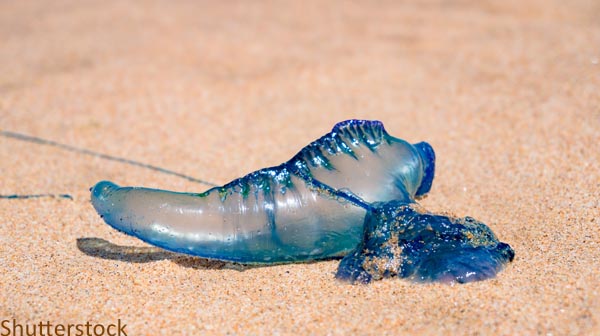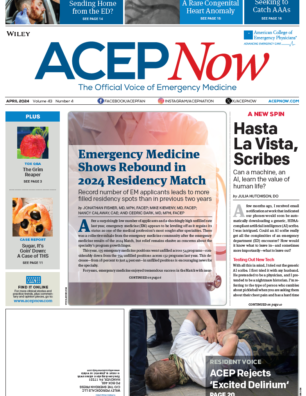
Pathophysiology and Symptoms: Contact with the tentacles causes local, sharp pain and an erythematous, maculopapular rash in a linear distribution that resolves after 24–72 hours. More significant toxicity can result in Irukandji syndrome (see above), cardiovascular collapse/dysrhythmia, and hemolysis.
Management: A small randomized controlled trial found Stingose to be superior to salt water irrigation in decreasing pain after Physalia envenomation.24 HWI may also be used. Irukandji syndrome should be managed the same way it is for C. barnesi envenomation.
Caveats: Avoid vinegar and methylated spirits because they increase firing of nematocysts. No antivenom is available.
References
- Nelson LS, Howland M, Lewin NA, et al. Goldfrank’s Toxicologic Emergencies, 11 ed. New York: McGraw-Hill, 2019.
- Tintinalli JE, Ma O, Yealy DM, et al. Tintinalli’s Emergency Medicine: A Comprehensive Study Guide, 9 ed. New York, NY: McGraw-Hill, 2020.
- Currie BJ, Jacups SP. Prospective study of Chironex fleckeri and other box jellyfish stings in the “Top End” of Australia’s Northern Territory. Med J Aust. 2005;183(11-12):631-636.
- Endean R. Separation of two myotoxins from nematocysts of the box jellyfish (Chironex fleckeri). Toxicon. 1987;25(5):483-492.
- Saggiomo SLA, Seymour JE. Cardiotoxic effects of venom fractions from the Australian box jellyfish Chironex fleckeri on human myocardiocytes. Toxicon. 2012;60(3):391-395.
- Rosson CL, Tolle SW. Management of marine stings and scrapes. West J Med. 1989;150(1):97-100.
- Henderson D, Easton RG. Stingose. A new and effective treatment for bites and stings. Med J Aus. 1980;2(3):146-150.
- Pereira PL, Carrette T, Cullen P, et al. Pressure immobilisation bandages in first-aid treatment of jellyfish envenomation: current recommendations reconsidered. Med J Aus. 2000;173(11-12):650-652.
- Fenner PJ, Williamson JA, Blenkin JA. Successful use of Chironex antivenom by members of the Queensland Ambulance Transport Brigade. Med J Aus. 1989;151(11-12):708-710.
- Tibballs J, Williams D, Sutherland SK. The effects of antivenom and verapamil on the haemodynamic actions of Chironex fleckeri (box jellyfish) venom. Anaesth Intensive Care. 1998;26(1):40-45.
- White J. A clinician’s guide to Australian venomous bites and stings. Melbourne: CSL Ltd., 2013. 245-263.
- Andreosso A, Smout MJ, Seymour JE. Dose and time dependence of box jellyfish antivenom. J Venom Anim Toxins Incl Trop Dis.2014;20:34.
- Konstantakopoulos N, Isbister GK, Seymour JE, et al. A cell-based assay for screening of antidotes to, and antivenom against Chironex fleckeri (box jellyfish) venom. J Pharmacol Toxicol Methods. 2009;59(3):166-170.
- Burnett JW, Calton GJ. Response of the box-jellyfish (Chironex fleckeri) cardiotoxin to intravenous administration of verapamil. Med J Aus. 1983;2(4):192-194.
- Burnett JW, Othman IB, Endean R, et al. Verapamil potentiation of Chironex (box-jellyfish) antivenom. Toxicon. 1990;28(2):242-244.
- Bloom DA, Burnett JW, Hebel JR, et al. Effects of verapamil and CSL antivenom on Chironex fleckeri (box-jellyfish) induced mortality. Toxicon. 1999; 37(11):1621-1626.
- O’Reilly GM, et al. Prospective study of jellyfish stings from tropical Australia, including the major box jellyfish Chironex fleckeri. Med J Aus. 2001;175(11-12):652-655.
- Currie BJ. Marine antivenoms. J Toxicol Clin Toxico 2003;41(3):301-308.
- Hartwick R, Callanan V, Williamson J. Disarming the box-jellyfish: nematocyst inhibition in Chironex fleckeri. Med J Aus. 1980;1(1):15-20.
- Grady JD, Burnett JW. Irukandji-like syndrome in South Florida divers. Ann Emerg Med. 2003;42(6):763-766.
- Yoshimoto CM, Yanagihara AA. Cnidarian (coelenterate) envenomations in Hawai’i improve following heat application. Trans R Soc Trop Med Hyg. 2002;96(3):300-303.
- Winkel KD, Tibballs J, Molenaar P, et al. Cardiovascular actions of the venom from the Irukandji (Carukia barnesi) jellyfish: effects in human, rat and guinea-pig tissues in vitro and in pigs in vitro. Clin Exp Pharmacol Physiol. 2005;32(9):777-788.
- Fenner PJ, Williamson JA. Worldwide deaths and severe envenomation from jellyfish stings. Med J Aust. 1996;165(11-12):658-661.
- Turner B, Sullivan P. Disarming the bluebottle: treatment of Physalia envenomation. Med J Aus. 1980;2(7):394-395.
Pages: 1 2 3 4 5 | Single Page





No Responses to “Emergen-Sea Medicine: Overview of Marine Envenomations”